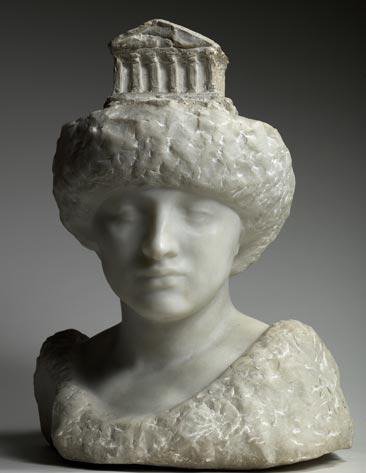Auguste Rodin
dal 18/11/2013 al 15/2/2014
Segnalato da
18/11/2013
Auguste Rodin
Rodin Museum, Paris
La lumiere de l'antique. Antiquity was a constant presence in Rodin's life, from his early days until his death; a guiding light continually offering a new perspective on his work. In his imaginary museum, the Greek sculptor Phidias and Michelangelo competed for his admiration.

"The Art of Antiquity signifies contentment, calm, balance, reason" - Auguste Rodin, 1911
Antiquity was a constant presence in Rodin’s life, from his early days until his death; a guiding light continually offering a new perspective on his work. Antiquity was initially a source of examples to be copied, but later, influenced by Michelangelo, it came to embody the luminous and joyful aspect of Rodin’s work, and became the symbol of the nature and life he sought to capture in his sculpture and his drawing. Rodin’s enthusiastic admiration for the models of Antiquity continued to grow, and they appeared in his later work in ever more subtle, barely perceptible ways. At that point, he was living happily at the Villa des Brillants in Meudon, and later in the Hôtel Biron, surrounded by a collection of over six thousand antique pieces. Between 1893 and 1917 he bought hundreds of Greek, Hellenic, Etruscan and Roman fragments in marble and in bronze from Parisian antique dealers, as well as terracotta vases and figurines.
Towards The Walking Man, Research into the Male Body
It was by observing some of the most famous models from Antiquity and the Renaissance that Rodin explored the representation of the male body. In his imaginary museum, the Greek sculptor Phidias and Michelangelo competed for his admiration. Rodin first of all used the composition of the Classical Belvedere Torso for his statue of The Thinker. His realisation that the fragment was as powerful and complete as the whole is illustrated in his partial works, the Torso of the Study for Saint John the Baptist and The Walking Man. “These are the damaged statues, found in the ruins; and they are no less masterpieces for being incomplete.” he wrote in 1907. This view of the incomplete body appears in the multiple fragments of feet, arms and legs that comprised the sculptor’s antique collection.
The Birth of Venus or The Expression of the Female Figure
From the 1890s onwards, Rodin worked on developing his own Venus through a number of female representations, all produced in the studio from a life model, but still ensuring continuity with the models of Antiquity. Initially inspired by an example of a crouching Venus, which influenced his female figures throughout the 1880s, he then turned towards the Venus de Milo, which imposed its presence in the 1890s in The Inner Voice and then The Whistler Muse. The Classical Esqueline Venus embodies the quest for a completeness that one finds in the artist’s later works, such as Aphrodite, Torso of a Young Woman with Arched Back and The Prayer. At the same time, Rodin collected more than one hundred fragments of Roman Venuses, building up a vast repertoire of shapes and drapery.
The Art of Metamorphoses, "Flowers in a Vase"
In the mid 1890s, Rodin began making assemblages with the antique vases from his collection and his own plaster figures. The object from the past changed its status to merge with the new work, both united in the same space and time. Rodin integrated pre-existing figures, mostly from the Gates of Hell, into the ancient terracotta object, or its plaster reproduction, like “flowers in a vase” (to use Rainer Maria Rilke’s expression). These maquettes could then be produced in marble or bronze. A Canosa vase that Rodin admired in the Musée du Louvre, was surrounded by antique vases from the collection where the human figure was part of the structure of the vase as a handle, belly or support, just like the artist’s assemblages
The Art of Metamorphoses, the Hybrid
Rodin was an assiduous reader of classical literature, in particular Ovid and Apuleius. It was from these, in particular, that he created the essential nature of his sculptures, through a process of metamorphosis, otherwise known as "assemblage". He reinterpreted, with increasing liberty and originality, the great stories of Antiquity: "Mythology exists to show us man’s eternal suffering and eternal joy, which the artist has to recreate with every new work…" Rodin was passionate about the strange nature of the fragments from Antiquity, whose fractures created “monsters”, and about the mythology of the hybrid that is prevalent in his work and in his collection.
Rodin’s Drawings and The Art of Antiquity
For the young Rodin, drawing was the ideal medium for making copies, as accurately as possible, of the most famous statues of Antiquity. The Musée du Louvre and the collections of engravings at the Imperial Library were his main sources of inspiration. After his visit to Italy in the winter of 1875-1876, when he saw the masterpieces of Michelangelo and of Antiquity, he adopted a freer drawing style in relation to the subject. In his later drawings, a little before 1900, Antiquity was no longer a subject in itself, but reappeared, in the form of mythological annotations, to express the attributes of a character, drawn from a life model in the secrecy of the studio. His semi-draped models and the eroticism of his figures reflect once again the art of Antiquity.
Image: Auguste Rodin, Pallas au Parthénon, 1896, Marbre, © Musée Rodin. Photo : Christian Baraja
Rodin Museum
79, rue de Varenne - Paris
Every day except Monday, 9:30 AM – 5:30 PM
Full rate €6.00 — Concessions €5.00



